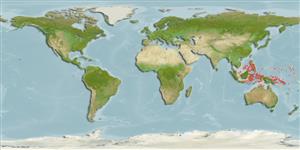Classification / Names
Common names from other countries
Main reference
Size / Weight / Age
Max length : 9.0 cm TL male/unsexed; (Ref. 48636)
Environment
Marine; reef-associated; depth range 2 - 12 m (Ref. 90102)
Climate / Range
Tropical, preferred ?; 19°N - 12°S
Distribution
Western Central Pacific: Indonesia, Philippines, Solomon Islands, New Guinea and Palau.
Countries | FAO areas | Ecosystems | Occurrences | Introductions
Short description
Dorsal
spines
(total): 9;
Dorsal
soft rays
(total): 9-10. This species differs from P. cryptus by having a concave rather than straight dorsal head profile, a higher modal gill raker count, and a series of five well-defined dark brown spots on the mid lateral line (these spots may be present on some P. cryptus, but are never well-defined). Best identified by the thin white barring on dorsal fin and upper sides (Ref. 48636). SL to 57 mm.
IUCN Red List Status (Ref. 115185)
Threat to humans
Harmless
Human uses
More information
ReferencesAquacultureAquaculture profileStrainsGeneticsAllele frequenciesHeritabilityDiseasesProcessingMass conversion
Tools
Special reports
Download XML
Internet sources
Estimates of some properties based on models
Phylogenetic diversity index
PD50 = 0.5010 many relatives (e.g. carps) 0.5 - 2.0 few relatives (e.g. lungfishes)
Trophic Level
3.4 ±0.4 se; Based on size and trophs of closest relatives
Resilience
High, minimum population doubling time less than 15 months (Preliminary K or Fecundity.)
Vulnerability
Low vulnerability (15 of 100)
Price category
